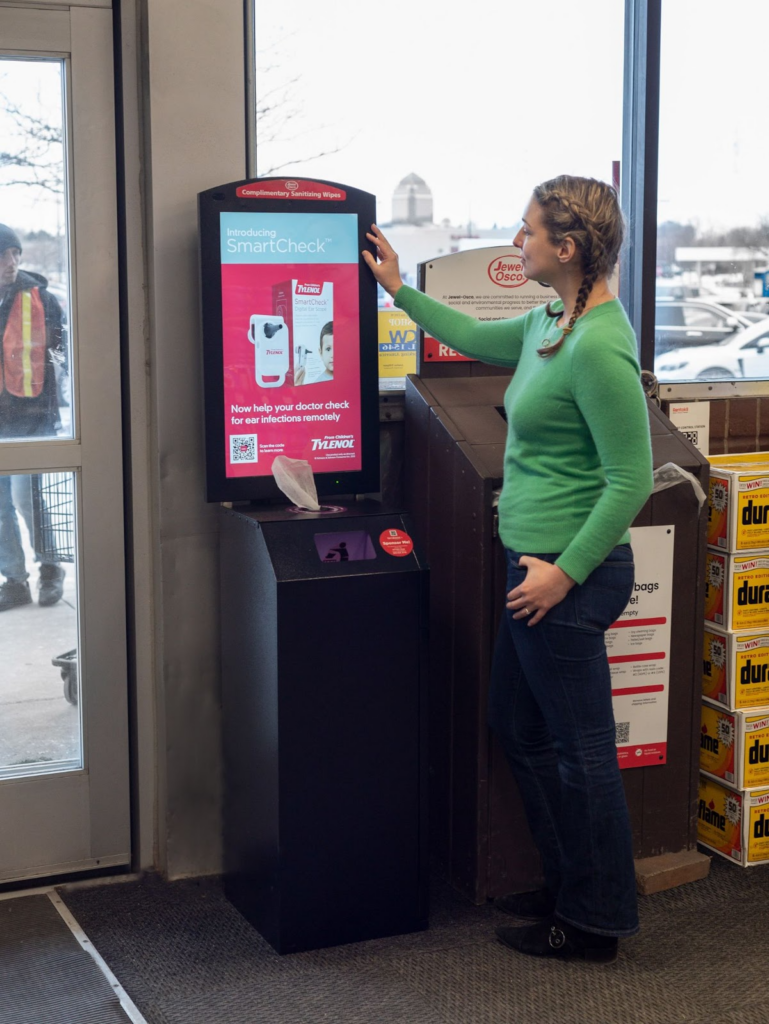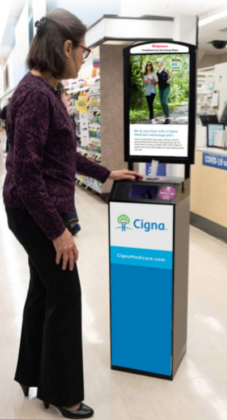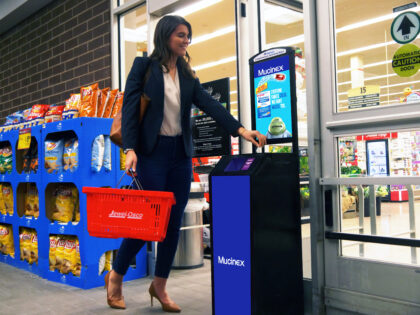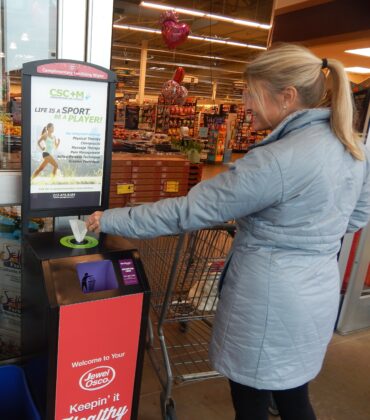The health insurance industry has tons of competitors, so carefully crafting an advertising campaign to stand out from the crowd is essential.
If you’re looking for expert marketing advice to boost your health insurance brand, this article will lay out all the essentials for you!
Health Insurance Advertising Mediums
Health insurance advertising mediums can be broken down into two categories– physical and digital ad space.
Physical advertising mediums can be non-digital out-of-home (OOH) advertising such as billboards and posters or digital out-home home (DOOH) advertising that uses digital screens which can be equipped with engaging animations and interactive elements. These ads target consumers when they are out in public and engaging with their surroundings, whether that be on the street or in stores. You may also consider print ads in newspapers and magazines, although those forms of physical advertising are becoming increasingly less popular.
Digital advertising can come in all sorts of forms, like social media content, pay-per-click ads, and email marketing to just name a few. Online ads are great because they provide vast reach and precise targeting through tracked internet data.
While both of these advertising mediums have their advantages, the most effective marketing campaigns synergize physical and digital ads to provide the biggest boost to engagement.
Why You Need Geofencing & Retargeting
Geofencing and retargeting are the most established tools to synergize your digital and physical advertising mediums. Both of these advertising tools utilize anonymized mobile data to precisely target consumers. Let’s break down how they do that.
Geofencing
Geofencing is a location-based targeting technique that sets up virtual boundaries around the regions you are advertising in. When someone crosses this virtual boundary, a pre-programmed advertisement will be delivered to their mobile device and appear the next time they use an internet platform like search engines or social media pages.
One way health insurance advertisers can utilize geofencing is to set up virtual boundaries around where your physical ads are displayed or around areas where you expect your consumer base to be. For example, these virtual boundaries could be placed near medical clinics and pharmacies to promote your insurance material to consumers who prioritize their health.
Retargeting
Retargeting is also known as remarketing because this tool advertises to consumers that have already been exposed to your brand. Let’s say that a shopper interacts with a Terraboost DOOH ad at their local pharmacy. This shopper’s anonymized mobile data could be tracked to send them online advertisements at a later date. Retargeting is a proven strategy to greatly increase customer conversion and boost your brand recognition.
Health Insurance Ad Examples
Physical Ad Examples

Just because you are using non-digital advertisements doesn’t mean that you can’t synergize them with your online promotional material! With QR codes, you can provide consumers with another point of contact to engage with your brand.

Digital advertisements located at the front of stores are ideal for catching the attention of consumers and getting them to engage with the interactive elements of your in-store campaign.
Digital Ad Examples

Humana’s digital marketing campaign utilized display ads that would appear on the websites of targeted consumer groups. This is a great example of how to use clear and concise messaging while also delivering a call to action.
Placements
Whether you are advertising in physical or online spaces, the placement of your ads should be specified to meet your target audience, budget, and overall objectives of your marketing campaign.
Physical ad placements
Many marketing campaigns have begun to favor in-store advertising because it can target consumers when they are engaging with their environment and making purchase decisions. For health insurance advertisers, finding physical ad placements that provide a contextual setting that matches your brand is ideal. While you could advertise in hospitals and doctors’ offices, consumers at these locations are generally in negative mental spaces and preoccupied, making them less open to promotional material.
One of the best physical ad placements for health insurance companies is pharmacy wait areas. Ad placements in pharmacy wait areas, such as those in CVS and Walgreens, are seen at a high frequency by both consumers getting prescriptions filled and in-store shoppers. Plus, these consumers are much more relaxed in this environment than they would be in hospitals and doctor’s offices and are therefore open to advertising material.
Pharmacy wait area advertising can come in a lot of forms, such as brochures, posters, or counter displays. But one of the most effective advertising mediums for this space is sanitizing billboards. These billboards drive engagement with your brand by encouraging consumers to stop for a moment, take a sanitizing wipe, and look at the sponsored company.
Digital ad placements
If you’re looking to utilize online advertising and tools like geofencing and retargeting, you’ll also need to consider where you want your brand to appear digitally.
Search engine ads are one of the most highly sought-after digital advertising spaces. These ads are highly targeted and will appear to specific consumer groups depending on what they search. The only downside to this advertising space is that it can be quite costly due to bidding competition for frequently used search terms.
You can also look to use display ads that will show banners and pop-up ads on websites or social media ads that appear in a user’s feed. These ads can be low-cost but have low clickthrough rates if they do not use eye-catching advertising. Digital natives have become so accustomed to pop-up ads and social media advertising that they are quick to spot them and either close out of them or scroll past them.
Best Practices
To get the best return on investment (ROI) from your health insurance marketing campaign, you’ll want to clearly lay out clear objectives for your campaign and track your progress towards those goals, such as increasing brand awareness or sales growth.
To have the best chance of succeeding across all your key performance indicators, you’ll need to spend plenty of time creating the optimal health insurance ad that will appeal to consumers.
Here are some key content factors that drive success in creating engaging advertisements:
- Ad copy: You don’t have much time to win consumers over, so the messaging on your promotional material must be clear, concise, and to the point. It’s a good idea to personalize your ads so that they resonate with the specific audience segment your health insurance company caters to.
- Colors: Bright colors are important to catch the eyes of consumers, but you don’t want them to impact the readability of your display. Your initial color choice for advertising is crucial as you’ll want the palette you select to be consistent across all your marketing materials to help consumers recognize your brand.
- Placement: Your advertising needs to be in areas that are frequented by your target audience. For health insurance companies, doctors’ offices, hospitals, and ideally, pharmacy waiting areas provide the correct contextual relevance that will help your advertising resonate with consumers.
These content factors may seem subjective, but advertising content choices can make a big difference in the success of your marketing campaign. That’s why it’s important to test and optimize your ads. This could involve rolling out two or more versions of your marketing material and seeing which one is more successful in driving customer conversion.
Conducting a marketing campaign can feel overwhelming as there are endless options to promote your brand, and it can be hard to choose the best path forward. If you’re looking for some guidance, you can always reach out to a Terraboost agent. Terraboost marketing agents are industry leaders and can provide you with key insights from working extensively with healthcare brands.
How Much Should You Spend On Health Insurance Advertising?
The cost of a health insurance advertising campaign will vary greatly depending on the medium you plan to use. Per month, digital billboards can cost up to $30,000 and cable TV spots can cost even more. However, these advertising mediums aren’t always the most cost-effective way to reach your target audience.
Terraboost’s sanitizing kiosks cost just $300-$400 or less a month and can be placed in the most coveted area for healthcare brands– pharmacy wait areas. With over 120,000 wellness billboards located in stores like CVS and Walgreens, you can place your branding in the optimal locations and extend your reach as far as needed.
Terraboost is an innovator when it comes to in-store marketing and has independent studies to back the success of its sanitizing billboards. These billboards drive impressive levels of engagement with 80% of shoppers taking a sanitizing wipe and 50% taking an accompanied coupon or brochure to learn more.
A successful marketing campaign is crucial to stand out from your competitors. So, if you’re looking to get ahead, reach out to a Terraboost agent today.



